Financial Accounting Report: Comparative Analysis of Unilever & Nestle
VerifiedAdded on 2023/04/06
|7
|723
|344
Report
AI Summary
This financial accounting report provides a comparative analysis of Unilever and Nestle's performance, focusing on key financial ratios to assess their profitability and asset utilization. The report examines operating profit ratio, net profit ratio, return on total assets, and return on equity for both companies, comparing their performance between 2016 and 2017. The analysis reveals that Unilever generally demonstrated stronger performance in these areas, with improvements in profitability and asset efficiency, while Nestle's performance showed some declines. The report includes calculations of these ratios, descriptions of the changes, and an analysis of the factors influencing the performance of each company, supported by references to company reports and other sources. The report concludes by summarizing the key findings and highlighting the relative strengths and weaknesses of each company based on the financial data provided.
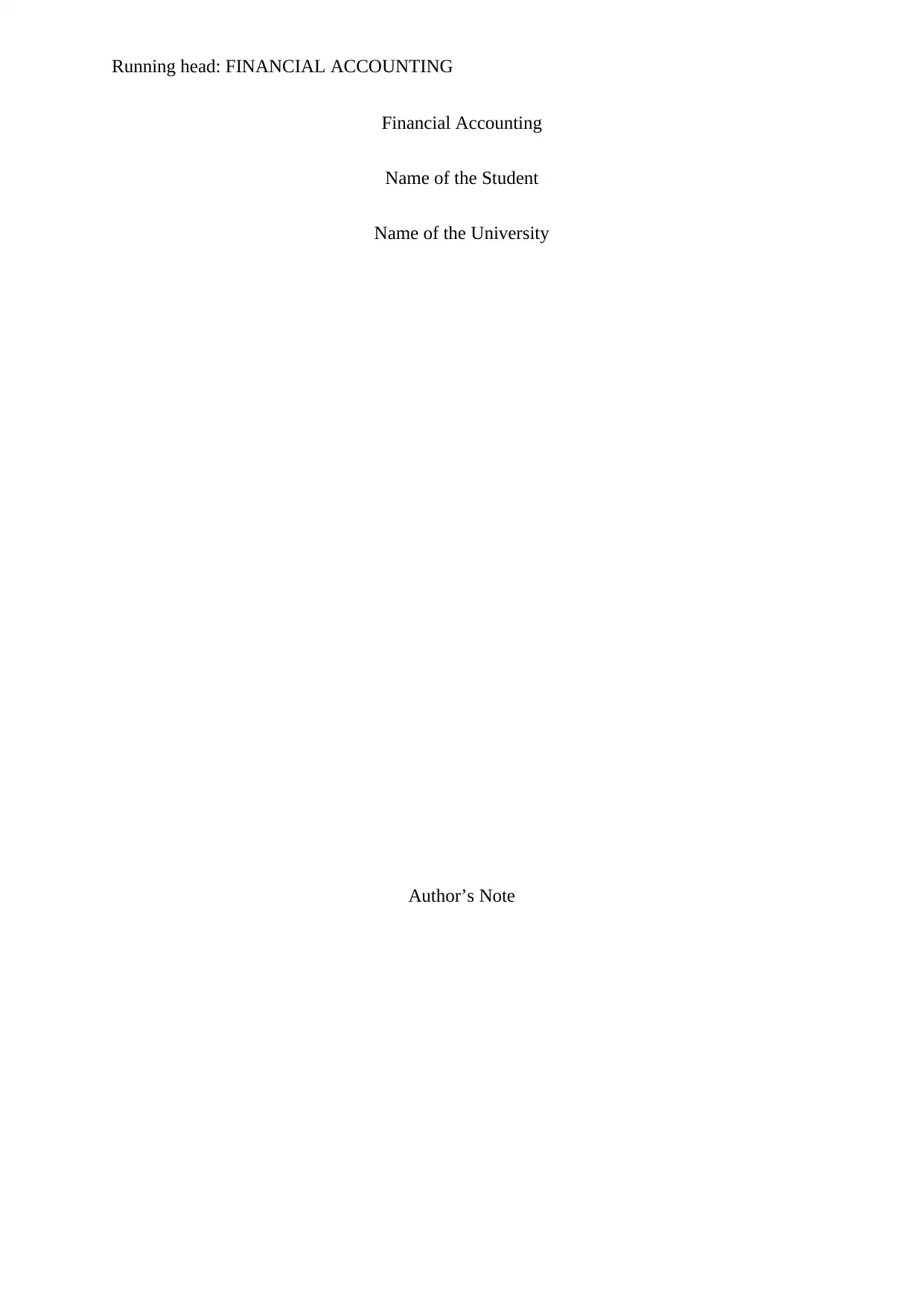
Running head: FINANCIAL ACCOUNTING
Financial Accounting
Name of the Student
Name of the University
Author’s Note
Financial Accounting
Name of the Student
Name of the University
Author’s Note
Paraphrase This Document
Need a fresh take? Get an instant paraphrase of this document with our AI Paraphraser
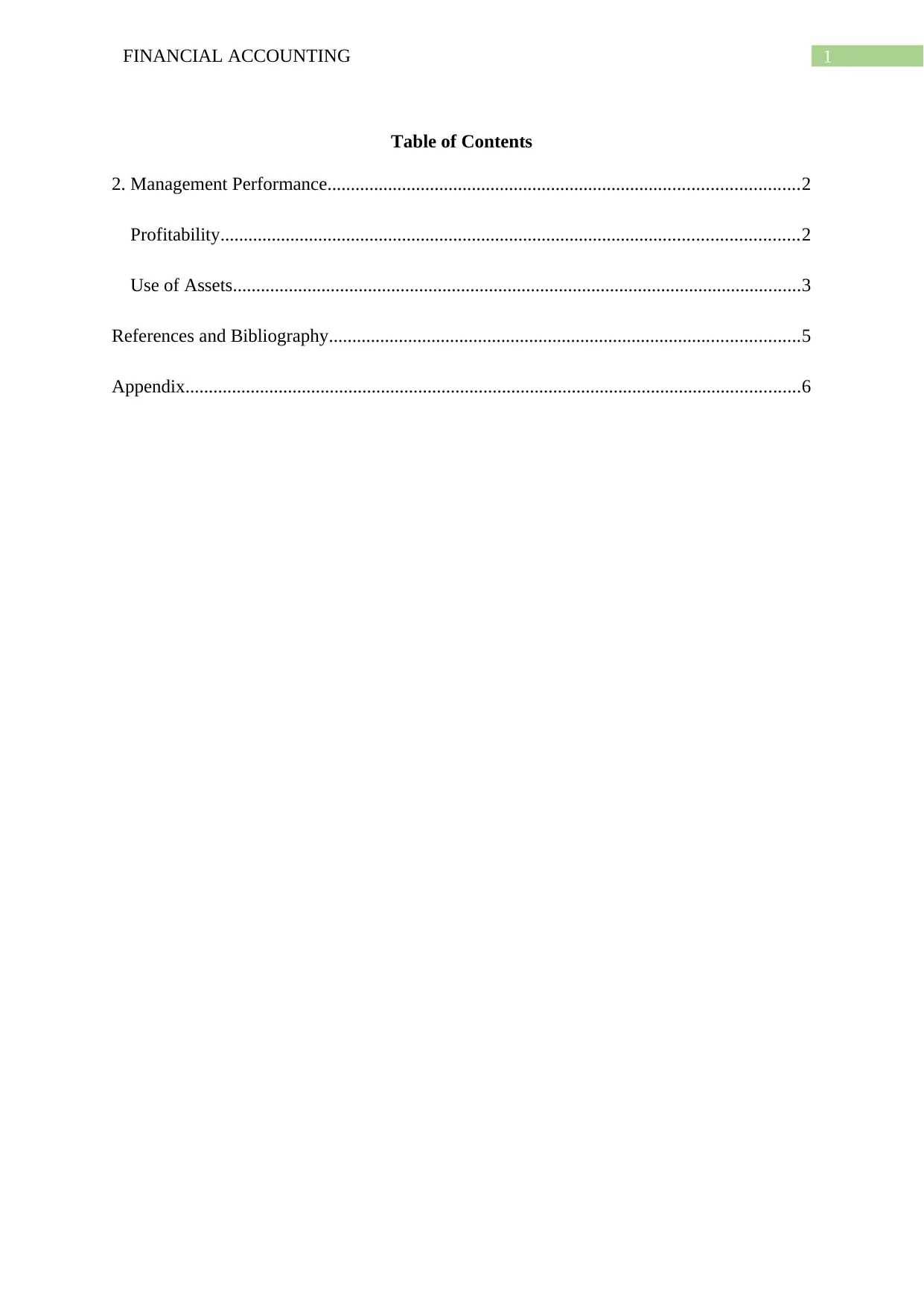
1FINANCIAL ACCOUNTING
Table of Contents
2. Management Performance.....................................................................................................2
Profitability............................................................................................................................2
Use of Assets..........................................................................................................................3
References and Bibliography.....................................................................................................5
Appendix....................................................................................................................................6
Table of Contents
2. Management Performance.....................................................................................................2
Profitability............................................................................................................................2
Use of Assets..........................................................................................................................3
References and Bibliography.....................................................................................................5
Appendix....................................................................................................................................6
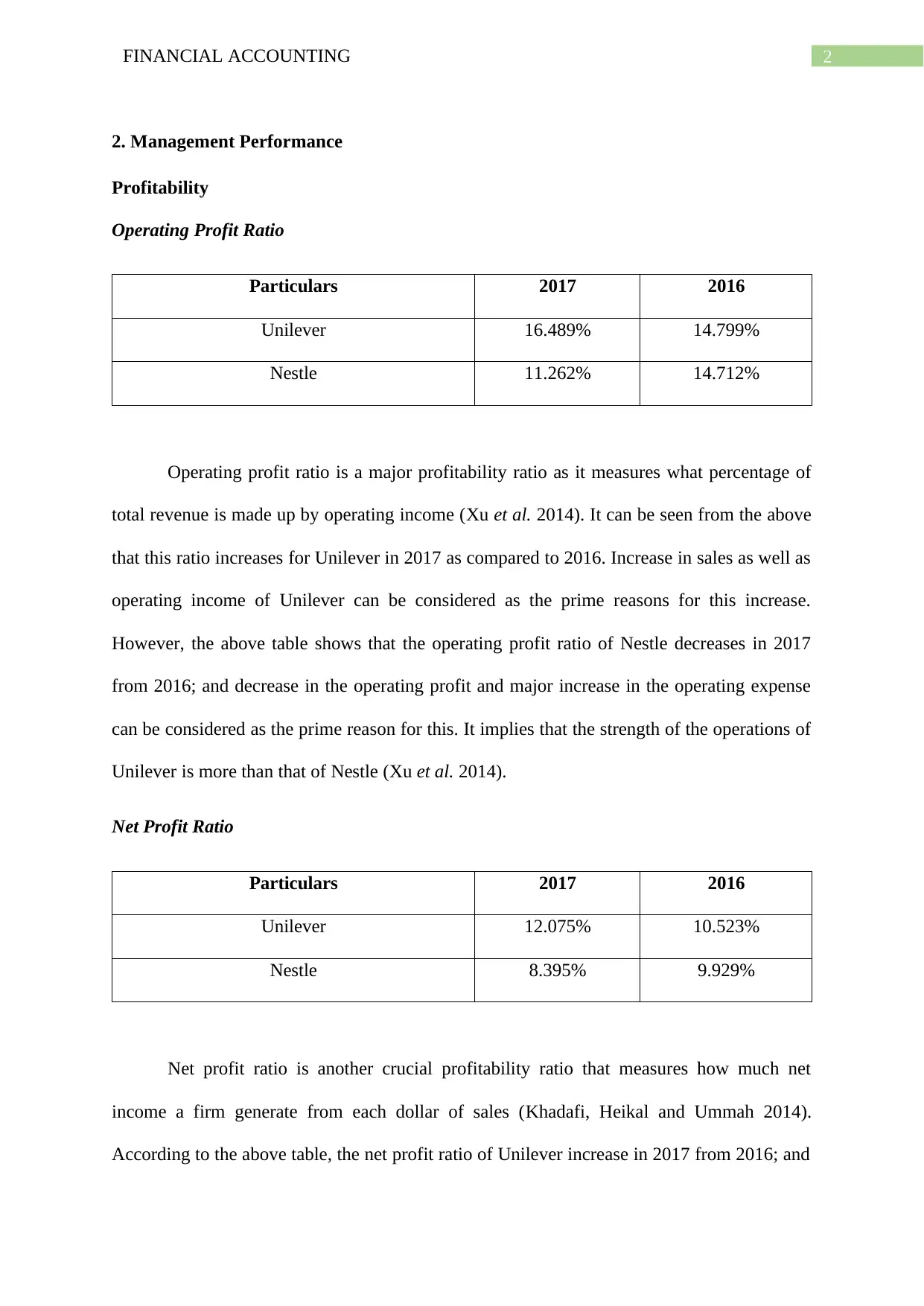
2FINANCIAL ACCOUNTING
2. Management Performance
Profitability
Operating Profit Ratio
Particulars 2017 2016
Unilever 16.489% 14.799%
Nestle 11.262% 14.712%
Operating profit ratio is a major profitability ratio as it measures what percentage of
total revenue is made up by operating income (Xu et al. 2014). It can be seen from the above
that this ratio increases for Unilever in 2017 as compared to 2016. Increase in sales as well as
operating income of Unilever can be considered as the prime reasons for this increase.
However, the above table shows that the operating profit ratio of Nestle decreases in 2017
from 2016; and decrease in the operating profit and major increase in the operating expense
can be considered as the prime reason for this. It implies that the strength of the operations of
Unilever is more than that of Nestle (Xu et al. 2014).
Net Profit Ratio
Particulars 2017 2016
Unilever 12.075% 10.523%
Nestle 8.395% 9.929%
Net profit ratio is another crucial profitability ratio that measures how much net
income a firm generate from each dollar of sales (Khadafi, Heikal and Ummah 2014).
According to the above table, the net profit ratio of Unilever increase in 2017 from 2016; and
2. Management Performance
Profitability
Operating Profit Ratio
Particulars 2017 2016
Unilever 16.489% 14.799%
Nestle 11.262% 14.712%
Operating profit ratio is a major profitability ratio as it measures what percentage of
total revenue is made up by operating income (Xu et al. 2014). It can be seen from the above
that this ratio increases for Unilever in 2017 as compared to 2016. Increase in sales as well as
operating income of Unilever can be considered as the prime reasons for this increase.
However, the above table shows that the operating profit ratio of Nestle decreases in 2017
from 2016; and decrease in the operating profit and major increase in the operating expense
can be considered as the prime reason for this. It implies that the strength of the operations of
Unilever is more than that of Nestle (Xu et al. 2014).
Net Profit Ratio
Particulars 2017 2016
Unilever 12.075% 10.523%
Nestle 8.395% 9.929%
Net profit ratio is another crucial profitability ratio that measures how much net
income a firm generate from each dollar of sales (Khadafi, Heikal and Ummah 2014).
According to the above table, the net profit ratio of Unilever increase in 2017 from 2016; and
⊘ This is a preview!⊘
Do you want full access?
Subscribe today to unlock all pages.

Trusted by 1+ million students worldwide
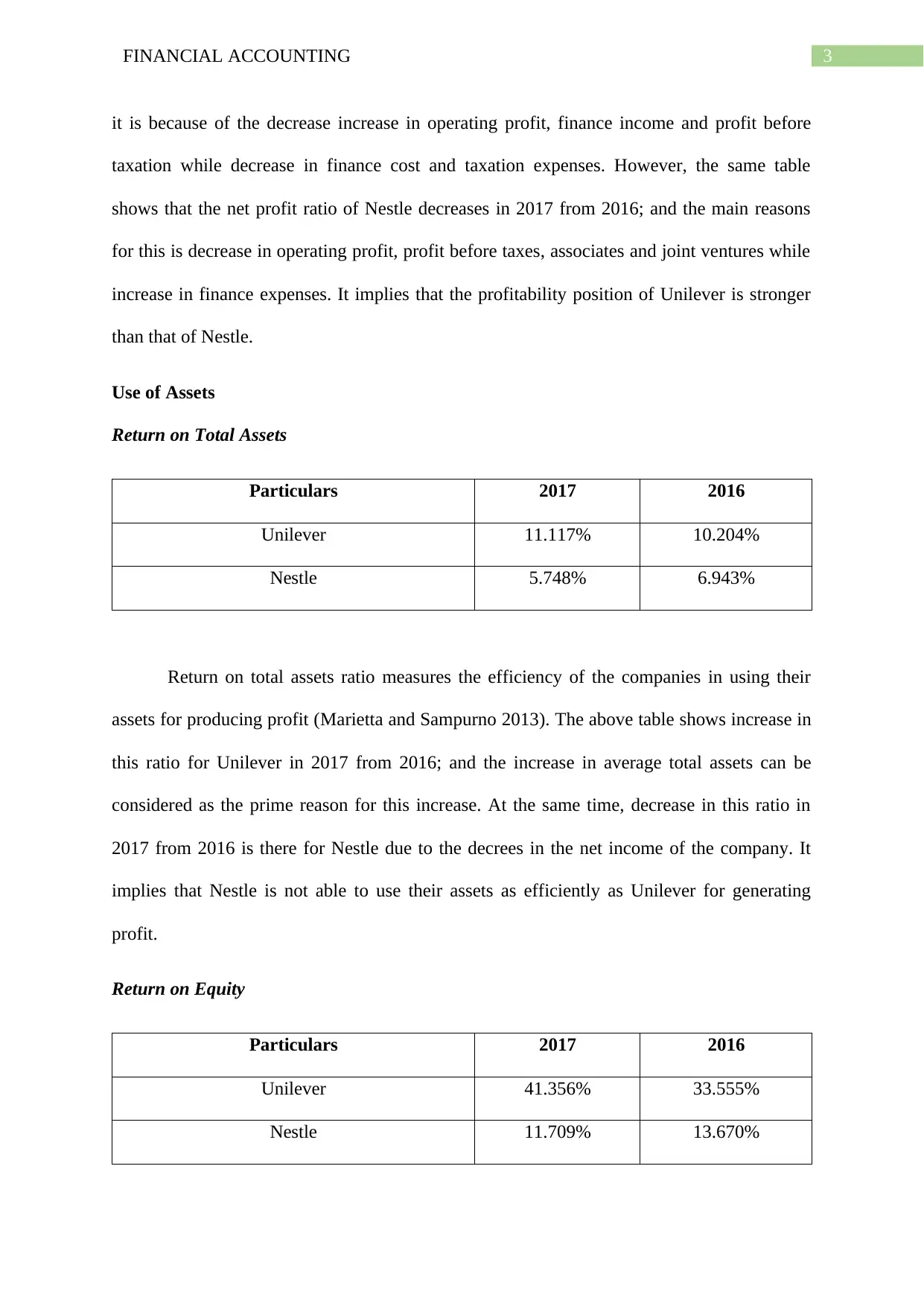
3FINANCIAL ACCOUNTING
it is because of the decrease increase in operating profit, finance income and profit before
taxation while decrease in finance cost and taxation expenses. However, the same table
shows that the net profit ratio of Nestle decreases in 2017 from 2016; and the main reasons
for this is decrease in operating profit, profit before taxes, associates and joint ventures while
increase in finance expenses. It implies that the profitability position of Unilever is stronger
than that of Nestle.
Use of Assets
Return on Total Assets
Particulars 2017 2016
Unilever 11.117% 10.204%
Nestle 5.748% 6.943%
Return on total assets ratio measures the efficiency of the companies in using their
assets for producing profit (Marietta and Sampurno 2013). The above table shows increase in
this ratio for Unilever in 2017 from 2016; and the increase in average total assets can be
considered as the prime reason for this increase. At the same time, decrease in this ratio in
2017 from 2016 is there for Nestle due to the decrees in the net income of the company. It
implies that Nestle is not able to use their assets as efficiently as Unilever for generating
profit.
Return on Equity
Particulars 2017 2016
Unilever 41.356% 33.555%
Nestle 11.709% 13.670%
it is because of the decrease increase in operating profit, finance income and profit before
taxation while decrease in finance cost and taxation expenses. However, the same table
shows that the net profit ratio of Nestle decreases in 2017 from 2016; and the main reasons
for this is decrease in operating profit, profit before taxes, associates and joint ventures while
increase in finance expenses. It implies that the profitability position of Unilever is stronger
than that of Nestle.
Use of Assets
Return on Total Assets
Particulars 2017 2016
Unilever 11.117% 10.204%
Nestle 5.748% 6.943%
Return on total assets ratio measures the efficiency of the companies in using their
assets for producing profit (Marietta and Sampurno 2013). The above table shows increase in
this ratio for Unilever in 2017 from 2016; and the increase in average total assets can be
considered as the prime reason for this increase. At the same time, decrease in this ratio in
2017 from 2016 is there for Nestle due to the decrees in the net income of the company. It
implies that Nestle is not able to use their assets as efficiently as Unilever for generating
profit.
Return on Equity
Particulars 2017 2016
Unilever 41.356% 33.555%
Nestle 11.709% 13.670%
Paraphrase This Document
Need a fresh take? Get an instant paraphrase of this document with our AI Paraphraser

4FINANCIAL ACCOUNTING
Return on equity is another major ratio that measures the ability of the companies in
producing profit by using the investments of the shareholders (Kijewska 2016). As per the
above table, return on equity of Unilever increases in 2017 from 2016; and the main reason
for this is the increase in net income while maintaining the same share capital. However, this
particular ratio decreases in 2017 from 2016 for Nestle due to the decrease in total equity
along with the decrease in the net income. It implies that Unilever is able to use their assets
more efficiently than Nestle for generating profit.
Return on equity is another major ratio that measures the ability of the companies in
producing profit by using the investments of the shareholders (Kijewska 2016). As per the
above table, return on equity of Unilever increases in 2017 from 2016; and the main reason
for this is the increase in net income while maintaining the same share capital. However, this
particular ratio decreases in 2017 from 2016 for Nestle due to the decrease in total equity
along with the decrease in the net income. It implies that Unilever is able to use their assets
more efficiently than Nestle for generating profit.
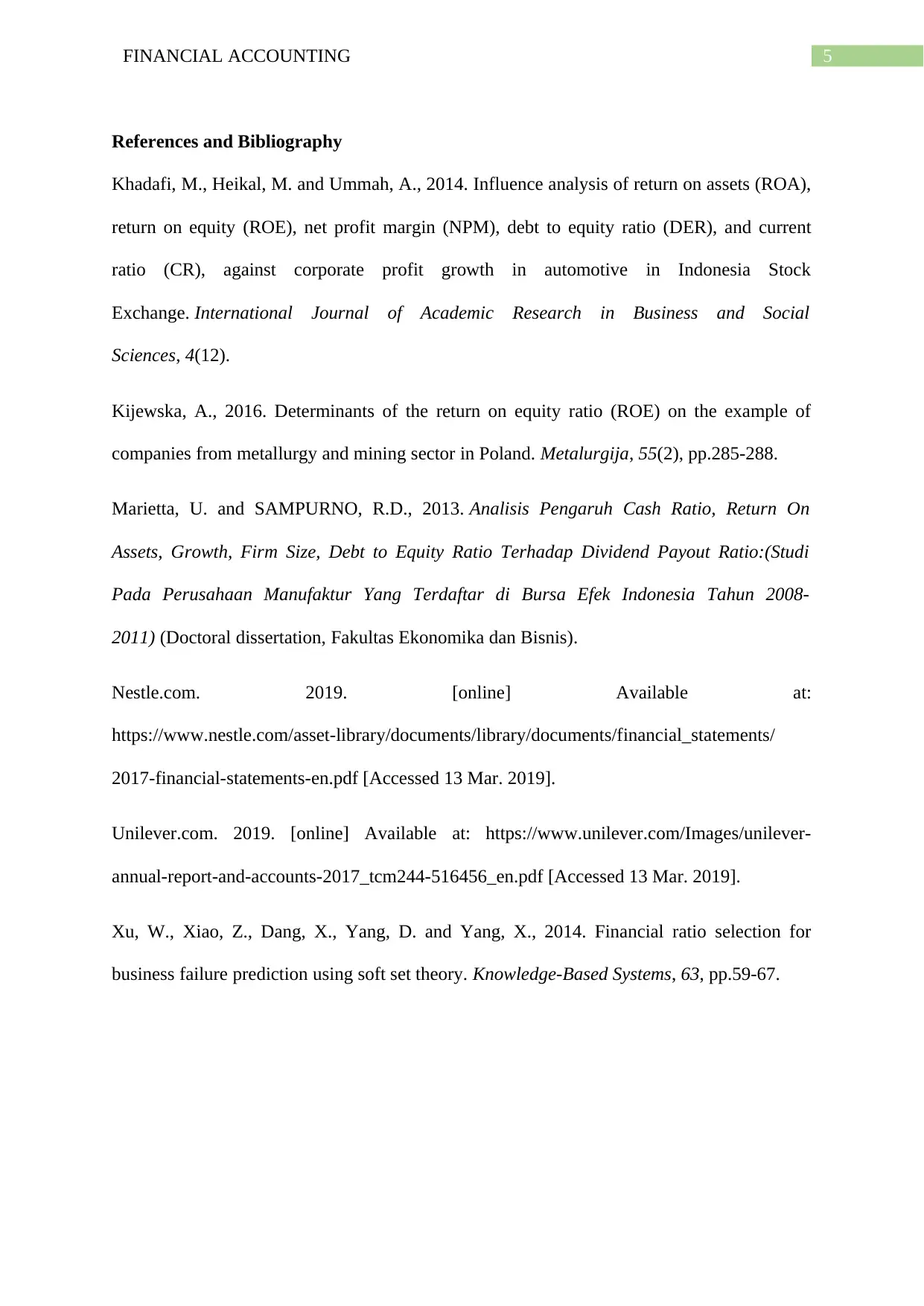
5FINANCIAL ACCOUNTING
References and Bibliography
Khadafi, M., Heikal, M. and Ummah, A., 2014. Influence analysis of return on assets (ROA),
return on equity (ROE), net profit margin (NPM), debt to equity ratio (DER), and current
ratio (CR), against corporate profit growth in automotive in Indonesia Stock
Exchange. International Journal of Academic Research in Business and Social
Sciences, 4(12).
Kijewska, A., 2016. Determinants of the return on equity ratio (ROE) on the example of
companies from metallurgy and mining sector in Poland. Metalurgija, 55(2), pp.285-288.
Marietta, U. and SAMPURNO, R.D., 2013. Analisis Pengaruh Cash Ratio, Return On
Assets, Growth, Firm Size, Debt to Equity Ratio Terhadap Dividend Payout Ratio:(Studi
Pada Perusahaan Manufaktur Yang Terdaftar di Bursa Efek Indonesia Tahun 2008-
2011) (Doctoral dissertation, Fakultas Ekonomika dan Bisnis).
Nestle.com. 2019. [online] Available at:
https://www.nestle.com/asset-library/documents/library/documents/financial_statements/
2017-financial-statements-en.pdf [Accessed 13 Mar. 2019].
Unilever.com. 2019. [online] Available at: https://www.unilever.com/Images/unilever-
annual-report-and-accounts-2017_tcm244-516456_en.pdf [Accessed 13 Mar. 2019].
Xu, W., Xiao, Z., Dang, X., Yang, D. and Yang, X., 2014. Financial ratio selection for
business failure prediction using soft set theory. Knowledge-Based Systems, 63, pp.59-67.
References and Bibliography
Khadafi, M., Heikal, M. and Ummah, A., 2014. Influence analysis of return on assets (ROA),
return on equity (ROE), net profit margin (NPM), debt to equity ratio (DER), and current
ratio (CR), against corporate profit growth in automotive in Indonesia Stock
Exchange. International Journal of Academic Research in Business and Social
Sciences, 4(12).
Kijewska, A., 2016. Determinants of the return on equity ratio (ROE) on the example of
companies from metallurgy and mining sector in Poland. Metalurgija, 55(2), pp.285-288.
Marietta, U. and SAMPURNO, R.D., 2013. Analisis Pengaruh Cash Ratio, Return On
Assets, Growth, Firm Size, Debt to Equity Ratio Terhadap Dividend Payout Ratio:(Studi
Pada Perusahaan Manufaktur Yang Terdaftar di Bursa Efek Indonesia Tahun 2008-
2011) (Doctoral dissertation, Fakultas Ekonomika dan Bisnis).
Nestle.com. 2019. [online] Available at:
https://www.nestle.com/asset-library/documents/library/documents/financial_statements/
2017-financial-statements-en.pdf [Accessed 13 Mar. 2019].
Unilever.com. 2019. [online] Available at: https://www.unilever.com/Images/unilever-
annual-report-and-accounts-2017_tcm244-516456_en.pdf [Accessed 13 Mar. 2019].
Xu, W., Xiao, Z., Dang, X., Yang, D. and Yang, X., 2014. Financial ratio selection for
business failure prediction using soft set theory. Knowledge-Based Systems, 63, pp.59-67.
⊘ This is a preview!⊘
Do you want full access?
Subscribe today to unlock all pages.

Trusted by 1+ million students worldwide
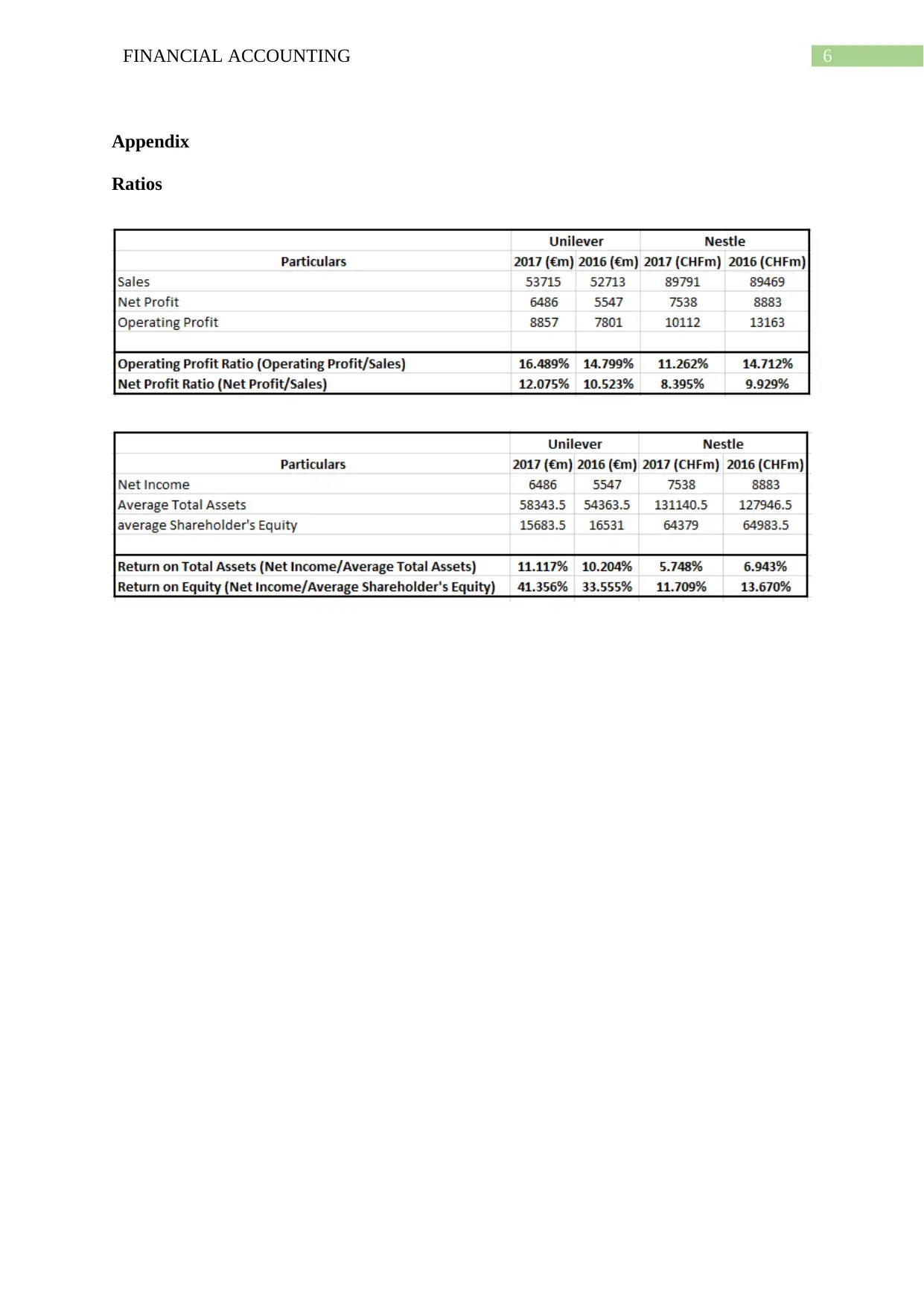
6FINANCIAL ACCOUNTING
Appendix
Ratios
Appendix
Ratios
1 out of 7
Related Documents
Your All-in-One AI-Powered Toolkit for Academic Success.
+13062052269
info@desklib.com
Available 24*7 on WhatsApp / Email
![[object Object]](/_next/static/media/star-bottom.7253800d.svg)
Unlock your academic potential
Copyright © 2020–2026 A2Z Services. All Rights Reserved. Developed and managed by ZUCOL.





